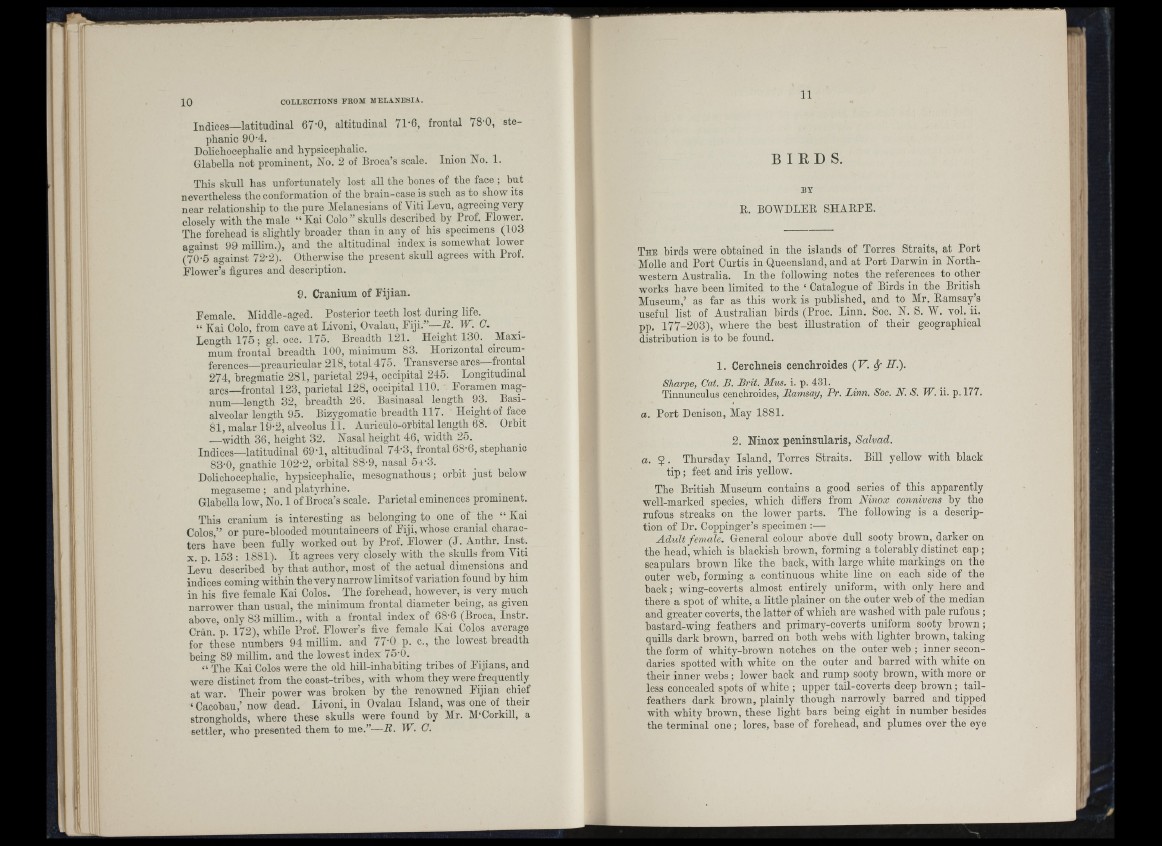
Indices—latitudinal 67'0, altitudinal 71‘6, frontal 78‘0, Stephanie
90-4.
Dolichocephalic and hypsicephalic.
Glabella not prominent, No. 2 of Broca’s scale. Inion No. 1.
This skull has unfortunately lost all the bones of the face ; but
nevertheless the conformation of the hrain-case is such as to show its
near relationship to the pure Melanesians of VitiLevu, agreeing very
closely with the male “ Kai Colo ” skulls described by Prof. Flower.
The forehead is slightly broader than in any of his specimens (103
against 99 millim.), and the altitudinal index is somewhat lower
(70-5 against 72-2). Otherwise the present skull agrees with Prof.
Flower’s figures and description.
9. Cranium of Fijian.
Female. Middle-aged. Posterior teeth lost during life.
“ Kai Colo, from cave at Livoni, Ovalau, Fiji.”—to. W. 0.
Length 175; gl. occ. 175. Breadth 121. Height 130. Maximum
frontal breadth 100, minimum 83. Horizontal circumferences—
preauricular 218, total 475. Transverse a rc s -fro n ta l
274, bregmatic 281, parietal 294, occipital 245. Longitudinal
a rc s -fro n ta l 123, parietal 128, occipital 110. Foramen magnum—^
length 32, breadth 26. Basinasal length 93. Basialveolar
length 95. Bizygomatic breadth 117. Height of face
81, malar 19-2, alveolus 11. Auriculo-orbital length 68. Orhit
—width 36, height 32. Nasal height 46, width 25.
Indices—latitudinal 69'1, altitudinal 74‘3, frontal 68’6, Stephanie
83-0, gnathic 102-2, orbital 88-9, nasal 5-t-3.
Dolichocephalic, hypsicephalic, mesognathous; orbit ju s t below
megaseme ; and platyrhine.
Glabella low. No. 1 of Broca’s scale. Parietal eminences prominent.
This cranium is interesting as belonging to one of the “ Kai
Colos,” or pure-blooded mountaineers of Fiji, whose cranial characters
have been fully worked out by Prof. Flower (J. Anthr. Inst_.
X. p. 153 : 1881). I t agrees very closely with the skulls from Ahti
Levu described by th at author, most of the actual dimensions and
indices coming within the very narrow limits of variation found by him
in his five female Kai Colos. The forehead, however, is very much
narrower than usual, the minimum frontal diameter being, as given
above, only 83 millim., with a frontal index of 68-6 (Broca, Instr.
Cran. p. 172), while Prof. Flower’s five female Kai Colos average
for these numbers 94 millim. and 77-0 p. c., the lowest breadth
being 89 millim. and the lowest index 75-0.
“ The Kai Colos were the old hill-inhabiting tribes of Fijians, and
were distinct from the coast-tribes, with whom they were frequently
at war. Their power was broken by the renowned Fijian chief
‘ Cacobau,’ now dead. Livoni, in Ovalau Island, was one of their
strongholds, where these skulls were found by Mr. M'Corkill, a
settler, who presented them to me.”—R. W. C.
11
B I R D S .
BY
B. BOAVDLEK SHARPE.
The birds were obtained in the islands of Torres Straits, at Port
Molle and Port Curtis in Queensland, and at Port Darwin in Northwestern
Australia. In the following notes the references to other
works have been limited to the ‘ Catalogue of Birds in the British
Museum,’ as far as this work is published, and to Mr. Ramsay’s
useful list of Australian birds (Proc. Linn. Soc. N. S. AY. vol. ii.
pp. 177-203), where the best illustration of their geographical
distribution is to he found.
1. Cerchneis cenchroides (F. ^ H.).
Sharpe, Cat. B. Brit. Mus. i. p. 431.
Tinnunculus cenchroides, Ramsay, Pr. Linn. Soc. N. S. W. ii. p. 177.
a. Port Denison, May 1881.
2. Ninox peninsnlaris, Salvad.
a. 5 . Thursday Island, Torres Straits. BiU yellow with black
t ip ; feet and iris yellow.
The British Museum contains a good series of this apparently
well-marked species, which differs from Ninox connivens by the
rufous streaks on the lower parts. The following is a description
of Dr. Coppinger’s specimen :—
A d u lt female. General colour above dull sooty brown, darker on
the head, which is blackish brown, forming a tolerably distinct cap ;
scapulars brown like the back, with large white markings on the
outer web, forming a continuous white line on each side of the
back; wing-coverts almost entirely uniform, with only here and
there a spot of white, a little plainer on the outer web of the median
and greater coverts, the latter of which are washed with pale rufous ;
hastard-wing feathers and primary-coverts uniform sooty brown ;
quills dark brown, barred on both webs with lighter brown, taking
the form of whity-hrown notches on the outer web ; inner secondaries
spotted with white on the outer and barred with white on
their inner webs; lower back and rump sooty brown, with more or
less concealed spots of white ; upper tail-coverts deep brown ; tail-
feathers dark brown, plainly though narrowly barred and tipped
with whity brown, these light bars being eight in number besides
the terminal o n e ; lores, base of forehead, and plumes over the eye